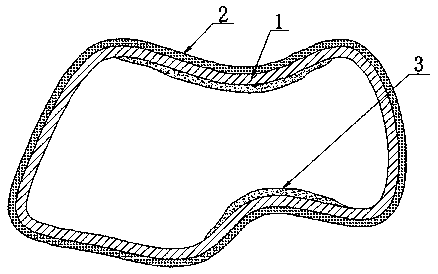Casting method adopting dual thin shell mold process
A thin shell and process technology, applied in casting molding equipment, molds, mold components, etc., can solve problems such as high cost, high energy consumption, and complexity, and achieve the effects of reducing pollution, improving production efficiency, and increasing connection strength.
- Summary
- Abstract
- Description
- Claims
- Application Information
AI Technical Summary
Problems solved by technology
Method used
Image
Examples
Embodiment 1
[0052] Its specific operation method:
[0053] 1. Make a 3D model of the thin shell mold 1 with a thickness of 1mm, and the amount of compensation for the inner wall.
[0054] 2. Using an LCD light-curing printer and light-curing resin materials, print out the thin shell mold 1 .
[0055] 3. Carry out the following surface smoothing treatment: first remove the outer support of the thin shell mold 1, perform ultrasonic cleaning, and then perform UV irradiation. In principle, the irradiation time is the same as the printing time.
[0056] 4. After the following 3 layers of dipping treatment, the shell mold 3 is produced.
[0057] The first layer: zircon paste + zircon sand
[0058] The second layer: zircon paste + zircon sand
[0059] The third layer: mullite pulp + mullite fine sand
[0060] Sealing pulp: mulai pulp
[0061] 5. Put the double-shell mold into the sand box for sand filling and reinforcement process, and add the lid of the sand box so that the gate is expose...
Embodiment 2
[0066] Its specific operation method:
[0067] 1) Make a 3D model of the thin shell mold 1 with a thickness of 1.5mm, and the amount of inner wall compensation.
[0068] 2) Use the FDM printer + plastic to print out the thin shell mold 1.
[0069] 3) Perform the following surface smoothing treatment: remove the external support of the thin shell mold 1 .
[0070] 4) After the following two layers of dipping treatment, the shell mold 3 is produced.
[0071] The first layer: zircon paste + zircon sand
[0072] The second layer: mullite pulp + mullite fine sand
[0073] Sealing pulp: mulai pulp
[0074] 5) Put it into the sand box for sand filling reinforcement process.
[0075] 6) Put the double-layer shell mold into a sintering furnace with a ventilation system, with the gate facing up, at a heating rate of 400° per hour, heat up to 1000° for 1 hour, so that the thin shell mold 1 is completely gasified .
[0076] 7) Casting the shell mold 3 in the sand box.
[0077] 8) ...
Embodiment 3
[0079] Its specific operation method:
[0080] a. Make a 3D model of the thin shell mold 1 with a thickness of 1mm, and the amount of inner wall compensation.
[0081] b. Print out the thin shell mold 1 by using a DLP light-curing printer and light-curing ceramic resin material.
[0082] c. Carry out the following surface smoothing treatment: ultrasonic cleaning first, and then UV irradiation. In principle, the irradiation time is the same as the printing time.
[0083] d. After the following 2-layer dipping treatment, the shell mold 3 is produced to form a double-layer shell mold.
[0084] The first layer: zircon paste + zircon sand
[0085] The second layer: zircon paste + zircon sand
[0086] Sealing pulp: mulai pulp
[0087] e. Put the double-layer shell mold into the sand box, and carry out the sand filling and strengthening process.
[0088] f. Put the sand box with double-shell mold into a sintering furnace with a ventilation system, with the gate facing upwards, ...
PUM
| Property | Measurement | Unit |
|---|---|---|
| thickness | aaaaa | aaaaa |
| thickness | aaaaa | aaaaa |
Abstract
Description
Claims
Application Information
 Login to View More
Login to View More - R&D
- Intellectual Property
- Life Sciences
- Materials
- Tech Scout
- Unparalleled Data Quality
- Higher Quality Content
- 60% Fewer Hallucinations
Browse by: Latest US Patents, China's latest patents, Technical Efficacy Thesaurus, Application Domain, Technology Topic, Popular Technical Reports.
© 2025 PatSnap. All rights reserved.Legal|Privacy policy|Modern Slavery Act Transparency Statement|Sitemap|About US| Contact US: help@patsnap.com

